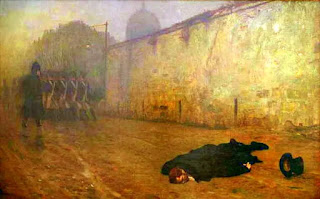When Napoleon was defeated, dethroned, and exiled for the second time in the summer of 1815, Ney was arrested (on 3 August 1815).
After a court-martial declared itself incompetent (November), he was tried (4 December 1815) for treason by the Chamber of Peers.
In order to save Ney's life, his lawyer Dupin declared that Ney was now Prussian and could not be judged by a French court as Ney's hometown of Sarrelouis had been annexed by Prussia according to the Treaty of Paris of 1815. Ney ruined his lawyer's effort by interrupting him and stating: "I am French and I will remain French".
On 6 December 1815, he was condemned, and executed by firing squad in Paris near the Luxembourg Garden on 7 December 1815, an event that deeply divided the French public. He refused to wear a blindfold and was allowed the right to give the order to fire, reportedly saying:
"Soldiers, when I give the command to fire, fire straight at my heart. Wait for the order. It will be my last to you. I protest against my condemnation. I have fought a hundred battles for France, and not one against her ... Soldiers, fire!"
Ney's execution was an example intended for Napoleon's other marshals and generals, many of whom were eventually exonerated by the Bourbon monarchy. Ney is buried in Paris at Père Lachaise Cemetery.

Comments
Post a Comment